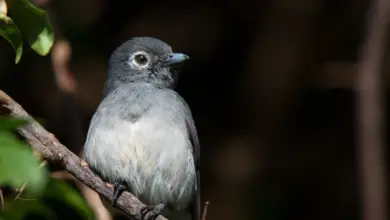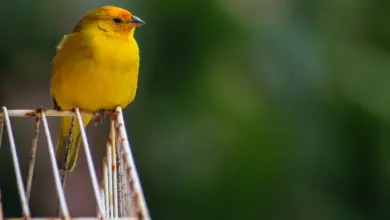Paradise Whydahs Finches are small, resident (non-migratory) African songbirds. These finches were named for the very long, flowing tails of the breeding males – a plumage detail that is thought to attract females during the breeding season. These finches are also known as Widow Birds because of their darker plumages and, again, their long black tails.
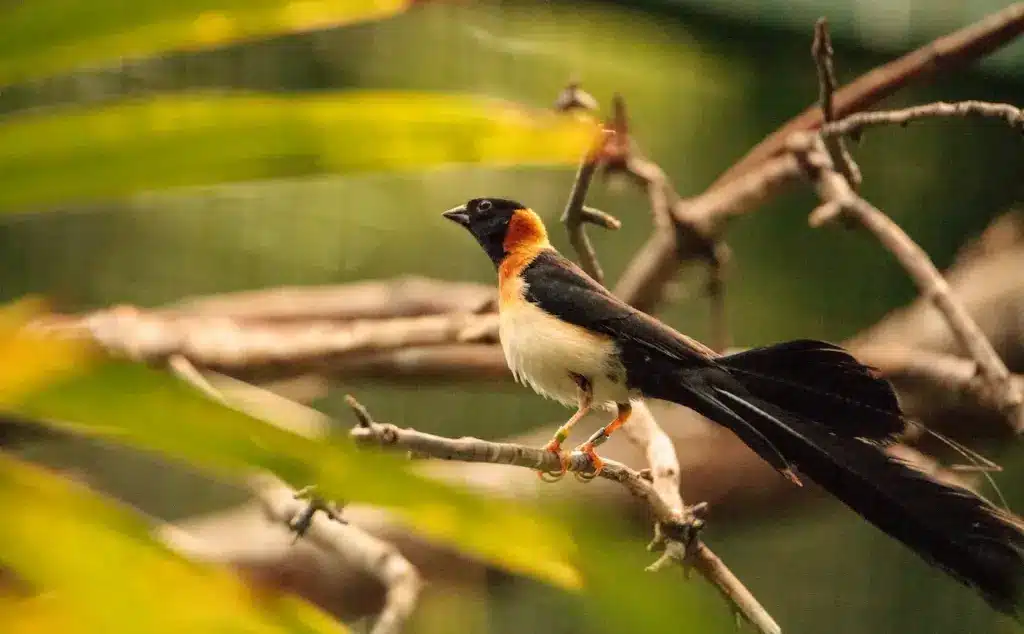
These gregarious birds are often seen in large flocks roosting in tree branches, which is a particularly spectacular sight during the breeding season when the males show off their magnificent long tails and glossy plumage.
Subspecies and Ranges:
The Paradise Whydah Finches are generally separated into 5 different species. Formerly they were considered conspecific (the same species) and all are sometimes placed in a separate genus: Steganura.
- Togo Paradise Whydah, Togo Paradise Widow, Vidua oogenesisFound in Benin, Cameroon, Chad, Ivory Coast, Ghana, Mali, Sierra Leone and Togo.
- Long-tailed Paradise Whydah, Exclamations Paradise-Whydah, Exclamatory Paradise Whydah, Exclamatory Whydah, Long-tailed Whydah, Long-tailed Widow, Nigerian Paradise Whydah, Uele Paradise Whydah, Uelle Paradise Whydah, Uelle Paradise Widow, Vidua interjecta
- Range: Eastern Africa, from east Sudan to south Angola.
- Eastern Paradise Whydah, Vidua paradisaea
- Range: Eastern Africa, from southeastern Sudan, Ethiopia (absent Ogaden desert and eastern Bale), Somalia, eastern Democratic Republic of Congo (Ruzizi Valley, in Kivu), eastern Uganda, Kenya, Tanzania, and from western and southern Angola and southern Zambia east to Malawi and Mozambique and south to central Namibia, central and southeastern Botswana, Zimbabwe, Swaziland and northern and northeastern South Africa. Generally, avoid the very arid southwest. Locally common below 1400m in dry wooded habitats and open bush.
- Northern Paradise Whydah, Broad-tailed Paradise Whydah, Broad-tailed Whydah, Vidua orientalis
- Range: West Africa
- Broad-tailed Paradise Whydah, Broad-tailed Paradise Widow, Broad-tailed Widow, Chapin’s Paradise-Whydah, Nyasa Paradise Whydah, Vidua obtusa
- Range: Angola, Botswana, Burundi, Democratic Republic of the Congo, Kenya, Malawi, Mozambique, Namibia, Rwanda, South Africa, Tanzania, Uganda, Zambia and Zimbabwe.
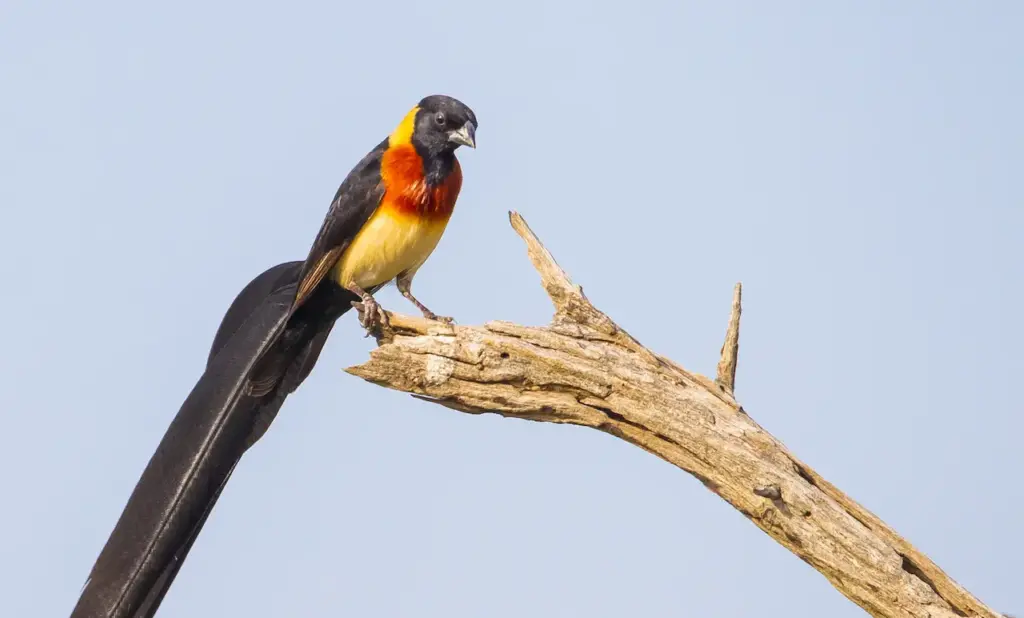
Description
Size
Male and female Paradise Whydah finches measure about 5 inches (13 cm) in length; except males in breeding plumage grow broad, long tail feathers that increase their length to 16 inches (~ 40 cm). Females and non-breeding males have short tails.
They average a weight of about 0.7 oz (21 grams).
Plumage Details / Males
Non-breeding males look like ordinary sparrows for part of the year with mostly brownish plumage (in different shades), black stripes on the crown, black marks on the face, a deep brown chest, and a creamy-colored abdomen. About 3 times a year they molt into their glossy breeding plumage with magnificent long tail feathers, which they lose when the season is over.
Breeding Males develop an attractive nuptial (breeding) plumage, with glossy black feathers on the head, back, wings, and tail, a vibrant rust color on the upper chest turning white towards the belly. They grow long tail feathers that can reach a length of 14 inches (36 cm) or more.
The bill is black, and the eyes and feet are blackish, dark grey, or pinkish brown.
Females
The upper parts are greyish-brown with blackish streaks. The head is boldly streaked buff and dark brown; except for a pale eye stripe and a vertical dark ‘C’ mark over the ears that is open towards the bill. Her chest is grey to buffy colored with some indistinct streaking. The abdomen and under tail coverts (feathers) are whitish. The wings below are pale grey. The bill is grey, paler on the base of the lower bill.
Gender ID
Non-breeding males and females look alike.
The breeding male can be identified by his black, chestnut, and buff plumage and long, flowing tail.
The female’s plumage is sparrow-like, with a broad whitish stripe down the center of her crown.
Juvenile Description
Immature birds have a plain greyish-brown upper plumage and a grey rump. The face is unmarked except for a slight pale grey eye stripe. The wings and tail are brownish-grey. The plumage below is a paler grey, except for a white belly and under tail coverts (feathers). The bill is black, except for brownish markings on the center of the upper bill and at the base of the lower bill. The eyes are dark brown. The legs and feet are brownish-grey to dark grey.
Diet / Feeding
Paradise Whyadhs feed on large grass seeds, including wild oats, millet, and spinifex, as well as taking the occasional termite and grubs. Most foraging is done on the ground or in bushes.
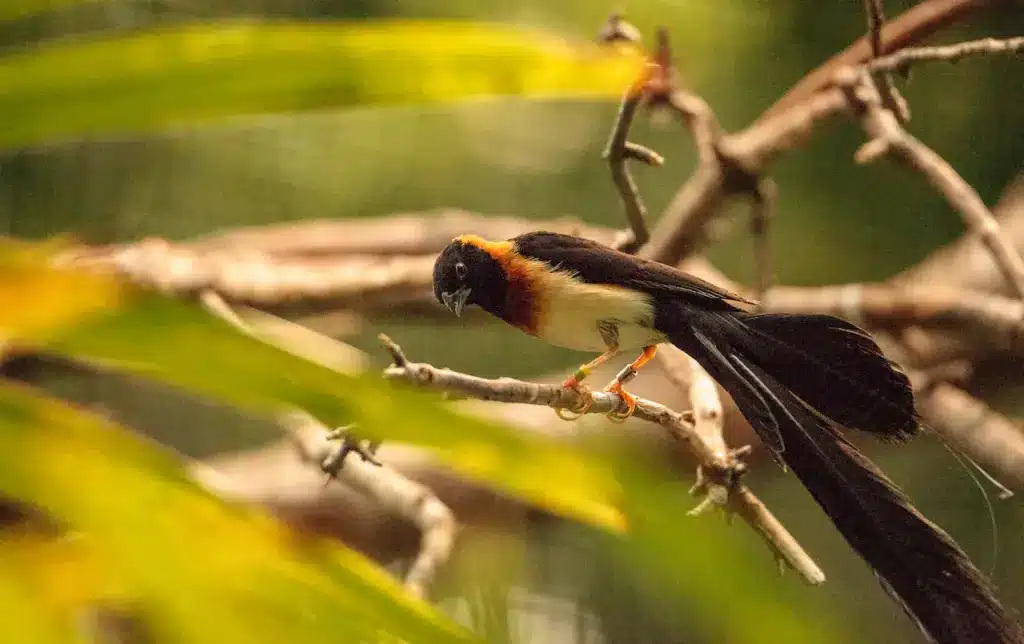
Breeding / Nesting
Males will mate with 10 or 12 females, who will lay their eggs into the nests of other finch species, specifically members of the family and often Green-winged Pytilias. However, in doing so, they don’t destroy the hosts’ eggs and simply add 3 – 4 white eggs to the clutch of the hosts, who end up raising both broods. Since the Whydah nestlings are generally larger and louder than the host nestlings, they have an advantage come feeding time.
The incubation time is usually between 11 – 13 days.
Captivity
Paradise Whydahs are challenging to breed – due to their brood-parasitic nature – however, these birds (the males in particular) are quite popular as pets or aviary birds.
These hardy birds are best kept in aviaries and if conditions are right, may successfully breed. Outside the breeding season, they could be kept with other finch species, but they tend to be aggressive when females of their species are present. Therefore, it is best to keep any male single if they are not to be bred. If breeding is desired, pairs should be separated during the breeding season, except for their hosts. Outside the breeding season, males are usually more docile.
One male is usually given several females – 3 to 4 females are usually optimal. If you have more females, you can increase the number of males. However, it is best to have at least three or more males in an aviary. Two males often fight to the death. When one aggressive male is confronted by two or more males, the chances of deadly aggression are reduced. Of course, the space has to be large enough to accommodate the number of birds kept in it. If the space is tight, even the most peaceful of all birds can turn aggressive. The females should have access to multiple active nests of suitable hosts. They generally favor birds of the genus Pytilia – often the Green-winged Pytilia nests.
As far as housing is concerned, they should have plenty of room to fly around. These active birds enjoy flying back and forward. During the mating season, males will carry their tails horizontally when flying. Their perches should be placed high enough to accommodate their long tails.
As far as diet is concerned, quality finch food and millet sprays are adequate. They also like live food – particularly when breeding.
Calls / Vocalizations / Sounds
These finches, in particular females, are generally silent.
Their occasional calls are described as shrill, metallic ‘teeet’s, and their songs as harsh chipping and chattering.
Breeding males often imitate the songs of other birds – in particular those that they have been raised by. These are also often the preferred hosts for their eggs. Females also learn to recognize the song of the foster birds they were raised by and choose mates with that same song.
Their nestlings also mimic the unique gape pattern of the nestlings of the host species.
Alternate (Global) Names
Afrikaans: Breestertparadysvink, Breëstertparadysvink, Gewone Paradysvink … Catalan: Vídua del paradís … Chinese: ?????, ?????,????, ????? … Czech: Vdovka sahelská / širokoocasá / rajská / tožská / dlouhoocasá … Danish: Paradisenke, Bredhalet Paradisenke. Korthalet Paradisenke, Togoparadisenke, Langhalet Paradisenke … Dutch: Breedstaartparadijswida, Breedstaart-paradijswida, Sahelparadijswida, Sahel-paradijswida, Smalstaartparadijswida, Togoparadijswida, Langstaartparadijswida, Langstaart-paradijswida … Finnish: Leveäpyrstöleski, sahelinparatiisileski, sirppiparatiisileski, Paratiisileski, suippoparatiisileski, kaitaparatiisileski … French: Veuve à collier d’or, Veuve à courte queue, Veuve à queue courte, Veuve de Chapin, Veuve à collier d’or de Verreaux, Veuve de paradis, Veuve du Togo, Veuve à longue queue, Veuve à queue large, Veuve d’Uelle, Veuve nigériane / nigérienne … German: Große Paradieswitwe, Senegalparadieswitwe, Breitschwanz-Paradieswitwe, Schmalschwanz-Paradieswitwe, Schmalschwanzwitwe, Spitzschwanz-Paradieswitwe, Togowitwe, Langschwanz-Paradieswitwe, Langschwanzwitwe … Irish: Víoda parthais … Italian: Vedova del Paradiso codalarga, Vedova paradisea codalarga, Vedova paradisea orientale / del Togo / codalunga … Japanese: obirohououjaku, minamiobirohououjaku, toagohououjaku, onagahououjaku … Kwangali: Harusira … Norwegian: Storhaleenke, Bredhaleenke, Langhaleenke, Paradisenke, Drageenke, Dragehaleenke … Polish: Wdówka ozdobna / szerokosterna / rajska, Viúva-do-paraíso-oriental, wdówka dlugosterna / d?ugosterna,rdzawoszyja … Portuguese: Viúva-do-paraíso-de-cauda-larga, Viúva-do-paraíso-orienta … Russian: ????????????? ??????? ????????, ????????????? ???????? … Shona: Nyambubundu … Slovak: Vdovka rajská / sahelská / širokochvostá / dlhochvostá .. . Spanish: Viuda del Paraíso Norteña de Cola Ancha, Viuda Coliancha / Chillona / del Paraíso de Cola Larga / de Togo, Togolesa … Swahili: Fumbwe Mkia-mrefu / Mkia-mpana … Swedish: Sudanparadisänka, Bredstjärtad paradisänka, Vanlig paradisänka, Långstjärtad paradisänka … Tsonga: Mitikahincila … Zulu: uJojokhaya
Recording
Species Research by Sibylle Johnson
Please Note: The images on this page are the sole property of the photographers (unless marked as Public Domain). Please contact the photographers directly concerning any copyright or licensing questions. Thank you.


